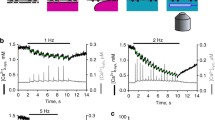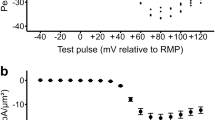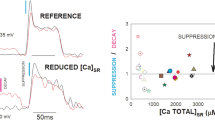Abstract
The contraction and relaxation of skeletal muscle is driven by release of Ca2+ from sarcoplasmic reticulum through the ryanodine receptor type 1 and extruding the ion from the cytosol by Ca2+ATPases. Efficient refilling of the empty Ca2+ stores is essential for repetitive cycles of muscle contraction and relaxation, but not investigated in human skeletal muscle cells. Here we show that under conditions of selective depletion of the ryanodine-sensitive Ca2+ pool Ca2+ influx occurs in differentiated human skeletal muscle cells using the Ca2+ imaging technique. This Ca2+ influx is not due to permeation through the L-type Ca2+ channel and not observed under conditions of inhibited Ca2+ ATPase. The Ca2+ influx was visualised by quenching the intracellular fura2 signal with Mn2+ on single cell level and also using fluorescence photometry of cell suspensions. The Mn2+ influx was inhibited by the Ca2+ channel blockers La3+ and SKF96356. The delineation of the signalling cascade leading to Ca2+ influx evoked by selective depletion of ryanodine sensitive Ca2+ stores showed that phospholipase C or protein kinase C were not involved. Interestingly, a Mn2+ influx was triggered by the cell-permeant analogue of diacylglycerol and further augmented by the application of RHC80267, a diacylglycerol lipase inhibitor. This signalling pathway could be attributed to the participation of a protein kinase C activity. However, Mn2+ influx evoked by selective depletion of ryanodine sensitive Ca2+ stores was not altered by RHC80267 or protein kinase C inhibitors. Using RT-PCR, correctly spliced mRNA fragments were detected corresponding to human transient receptor potential (TRPC) Ca2+ channels type 1, 3, 4 and 6. These data show that in skeletal muscle at least two independent mechanisms of Ca2+ influx exist. For Ca2+ influx triggered by the selective depletion of ryanodine sensitive Ca2+ stores we propose a phospholipase C independent coupling of ryanodine receptors to voltage insensitive Ca2+ channels.







Similar content being viewed by others
References
Alberola IJ, Takaki S, Kerner JD, Perlmutter RM (1997) Differential signalling by lymphocyte antigen receptors. Annu Rev Immunol 15:125–154
Barrit GJ (1999) Receptor-activated Ca2+ inflow in animal cells: a variety of pathways tailored to meet different intracellular Ca2+ signalling requirements. Biochem J 337:153–169
Baroffio A, Aubry JP, Kaelin A, Krause RM, Hamann M, Bader CR (1993) Purification of human muscle satellite cells by flow cytometry. Muscle Nerve 16:498–505
Berridge MJ (1997) Lymphocyte activation in health and disease. Crit Rev Immunol 17:155–178
Berridge MJ, Bootman MD, Lipp P (1998) Calcium-a life and death signal. Nature 395:645–648
Bootman MD, Collins TJ, Mackenzie L, Roderick HL, Berridge MJ, Peppiatt CM (2002) 2-aminoethoxydiphenyl borate (2-APB) is a reliable blocker of store-operated Ca2+ entry but an inconsistent inhibitor of InsP3-induced Ca2+ release. FASEB J 16:1145–1150
Boulay G, Zhu X, Peyton M, Jiang M, Hurst R, Stefani E, L Birnbaumer (1997) Cloning and expression of a novel mammalian homolog of Drosophila transient receptor potential (TRPC) involved in calcium entry secondary to activation of receptors coupled by the Gq class of G protein. J Biol Chem 272:29672–29680
Brinkmeier H, Seewald MJ, Eichinger HM, Rudel R (1993) Culture conditions for the production of porcine myotubes and myoballs. J Anim Sci 71:1154–1160
Clapham DE (1995) Calcium signalling. Cell 80:259–268
De Smet P, Parys JB, Callewaert G, Weidema AF, Hill E, De Smedt H, Erneux C, Sorrentino V, Missiaen L (1999) Xestospongin C is an equally potent inhibitor of the inositol 1,4,5-trisphosphate receptor and the endoplasmic-reticulum Ca2+ pumps. Cell Calcium 26:9–13
Franzini-Armstrong C (2000) The sarcoplasmic reticulum and the control of muscle contraction. FASEB J 13:S266–S270
Garcia RL, Schilling WP (1997) Differential expression of mammalian TRPC homologues across tissue and cell lines. Biochem Biophys Res Commun 239:279–283
Groschner K, Hingel S, Lintschinger B, Balzer M, Romanin C, Zhu X, Schreibmayer W (1998) TRPC proteins form store-operated cation channels in human vascular endothelial cells. FEBS Lett 437:101–106
Grynkiewicz G, Poenie M, Tsien RY (1985) A new generation of Ca2+ indicators with greatly improved fluorescence properties. J Biol Chem 260:3440–3450
Guse AH (1998) Ca2+ Signalling in the T-lymphocytes. Crit Rev Immunol 18:419–448
Herrmann-Frank A, Luttgau HC, Stephenson DG (1999) Caffeine and excitation-contraction coupling in skeletal muscle: a stimulating story. J Muscle Res Cell Motil 20:223–237
Hofmann T, Obukhov AG, Schaefer M, Harteneck C, Gudermann T, Schultz G (1999) Direct activation of human TRPC6 and TRPC3 channels by diacylglycerol. Nature 397:259–263
Hofmann T, Schaefer M, Schultz G, Gudermann T (2000) Transient receptor potential channels as molecular substrates of receptor-mediated cation entry. J Mol Med 78:14–25
Hohenegger M, Mathyash M, Poussu K, Herrmann-Frank A, Sarközi S, Lehmann-Horn F, Freissmuth M (1996) Activation of the skeletal muscle ryanodine receptor by suramin and suramin analogs. Mol Pharmacol 50:1443–1453
Hopf FW, Reddy P, Hong J, Steinhardt RA (1996a) A capacitative calcium current in cultured skeletal muscle cells is mediated by the calcium-specific leak channel and inhibited by dihydropyridine compounds. J Biol Chem 271:22358–22367
Hopf FW, Turner PR, Denetclaw WF, Reddy P, Steinhardt RA (1996b) A critical evaluation of resting intracellular free calcium regulation in dystrophic mdx muscle. Am J Physiol 271:C1325–C1339
Irvine RF (1990) 'Quantal' Ca2+ release and the control of Ca2+ entry by inositol phosphates, a possible mechanism. FEBS Lett 263:5–9
Kass GE, Chow SC, Gahm A, Webb DL, Berggren PO, Llopis J, Orrenius S (1994) Two separate plasma membrane Ca2+ carriers participate in receptor-mediated Ca2+ influx in rat hepatocytes. Biochim Biophys Acta 1223:226–233
Kiselyov K, Xu X, Mozhayeva G, Kuo T, Pessah I, Mignery G, Zhu X, Birnbaumer L, Muallem S (1998) Functional interaction between InsP3 receptors and store-operated HTRPC3 channels. Nature 396:478–482
Kiselyov KI, Shin DM, Wang Y, Pessah IN, Allen PD, Muallem S (2000) Gating of store-operated channels by conformational coupling to ryanodine receptors. Mol Cell 6:421–431
Klinger M, Freissmuth M, Nickel P, Stäbler-Schwarzbart M, Kassack M, Suko J, Hohenegger M (1999) Suramin and suramin analogs activate skeletal muscle ryanodine receptor via a calmodulin binding site. Mol Pharmacol 55:462–472
Kurebayashi N, Ogawa Y (2001) Depletion of Ca2+ in the sarcoplasmic reticulum stimulates Ca2+ entry into mouse skeletal muscle fibres. J Physiol 533:185–199
Kwan CY, Takemura H, Obie JF, Thastrup O, Putney JW (1990) Effects of MeCh, thapsigargin, and La3+ on plasmalemal and intracellular Ca2+ transport in lacrimal acinar cells. Am J Physiol 258:C1006–C1015
Liu W, Meissner G (1997) Structure-activity relationship of xanthines and skeletal muscle ryanodine receptor/Ca2+ release channel. Pharmacology 54:135–143
Mizuno N, Kitayama S, Saishin Y, Shimada S, Morita K, Mitsuhata C, Kurihara H, Dohi T (1999) Molecular cloning and characterization of rat TRPC homologues from brain. Brain Res Mol Brain Res 64:41–51
Montell C (2001) Physiology, phylogeny and functions of the TRPC superfamily of cation channels. Sci STKE 90:1–17
O'Brien JJ, Feng W, Allen PD, Chen SR, Pessah IN, Beam KG (2002) Ca2+ activation of RyR1 is not necessary for the initiation of skeletal-type excitation-contraction coupling. Biophys J 82:2428–2435
Okada T, Shimizu S, Wakamori M, Maeda A, Kurosaki T, Takada N, Imoto K, Mori Y (1998) Molecular cloning and functional characterization of a novel receptor-activated TRPC Ca2+ channel from mouse brain. J Biol Chem 273:10279–10287
Pan Z, Yang D, Nagaraj RY, Nosek TA, Nishi M, Takeshima H, Cheng H, Ma J (2002) Dysfunction of store-operated calcium channel in muscle cells lacking mg29. Nat Cell Biol 4:379–383
Parekh AB, Penner R (1997) Store depletion and calcium influx. Physiol Rev 77:901–930
Philipp S, Hambrecht J, Braslavski L, Schroth G, Freichel M, Murakami M, Cavalie A, Flockerzi V (1998) A novel capacitative calcium entry channel expressed in excitable cells. EMBO J 17:4274–4282
Putney JW (1986) A model for receptor mediated calcium entry. Cell Calcium 7:1–12
Putney JW, McKay RR (1999) Capacitative calcium entry. Bioessays 21:38–46
Randriamampita C, Tsien RY (1993) Emptying of intracellular Ca2+ stores releases a novel small messenger that stimulates Ca2+ influx. Nature 364:809–814
Robertson TP, Hague D, Aaronson PI, Ward JP (2000) Voltage-independent calcium entry in hypoxic pulmonary vasoconstriction of intrapulmonary arteries of the rat. J Physiol 525:669–680
Rosado JA, Sage SO (2000) Coupling between inositol 1,4,5-trisphosphate receptors and human transient receptor potential channel 1 when intracellular Ca2+ stores are depleted. Biochem J 350:631–635
Runnels LW, Yue L, Clapham DE (2001) TRP-PLIK, a bifunctional protein with kinase and ion channel activities. Science 291:1043–1047
Rzigalinski BA, Willoughby KA, Hoffman SW, Falck JR, Ellis EF (1999) Calcium influx factor, further evidence it is 5, 6-epoxyeicosatrienoic acid. J Biol Chem 274:175–182
Schneider MF (1994) Control of calcium release in functioning skeletal muscle fibres. Annu Rev Physiol 56:463–484
Tanabe T, Beam KG, Adams BA, Niidome T, Numa S (1990) Regions of the skeletal muscle dihydropyridine receptor critical for excitation-contraction coupling. Nature 346:567–569
Tanabe T, Adams BA, Numa S, Beam KG (1991) Repeat I of the dihydropyridine receptor is critical in determining calcium channel activation kinetics. Nature 352:800–803
Thastrup O, Dawson AP, Scharff O, Foder B, Cullen PJ, Drobak BK, Bjerrum PJ, Christensen SB, Hanley MR (1994) Thapsigargin, a novel molecular probe for studying intracellular calcium release and storage. Agents Actions 43:187–193
Thomas AB, Delaville F (1991) The use of fluorescent indicators for measurements of cytosolic-free calcium concentration in cell populations and single cells. In: McCormack JG, Cobbold PH (eds) Cellular calcium: a practical approach. Oxford University Press, Oxford, pp 1–54
Weigl L, Hohenegger M, Kress HG (2000) Dihydropyridine-induced Ca2+ release from ryanodine-sensitive Ca2+ pools in human skeletal muscle cells. J Physiol 525:461–469
Xu X, Star RA, Tortorici G, Muallem S (1994) Depletion of intracellular Ca2+ stores activates nitric-oxide synthase to generate cGMP and regulate Ca2+ influx. J Biol Chem 269:12645–12653
Zhu X, Jiang M, Birnbaumer L (1998) Receptor-activated Ca2+ influx via human TRPC3 stably expressed in human embryonic kidney (HEK)293 cells. Evidence for a non-capacitative Ca2+ entry. J Biol Chem 273:133–142
Zitt C, Obukhov AG, Strubing C, Zobel A, Kalkbrenner F, Luckhoff A, Schultz G (1997) Expression of TRPCC3 in Chinese hamster ovary cells results in calcium-activated cation currents not related to store depletion. J Cell Biol 138:1333–1341
Acknowledgements
We are grateful to M. Freissmuth (Vienna) and H. Kubista (Vienna) for helpful discussion and critical reading of the manuscript and S. Boehm and E. Moskvina for providing us with hippocampal cDNA. This work was supported by research grants of the "Fonds zur Förderung der wissenschaftlichen Forschung" (P-14940 to M.H.), the OeNB Jubiläumsfond (No. 6646 to M.H.; and No. 8266 L.W.), the Hochschuljubiläumsstiftung der Stadt Wien (H-27/2000 to M.H.) and the Anton Dreher-Gedächtnisstiftung (to MH).
Author information
Authors and Affiliations
Corresponding author
Rights and permissions
About this article
Cite this article
Weigl, L., Zidar, A., Gscheidlinger, R. et al. Store operated Ca2+ influx by selective depletion of ryanodine sensitive Ca2+ pools in primary human skeletal muscle cells. Naunyn-Schmiedeberg's Arch Pharmacol 367, 353–363 (2003). https://doi.org/10.1007/s00210-003-0705-8
Received:
Accepted:
Published:
Issue Date:
DOI: https://doi.org/10.1007/s00210-003-0705-8




